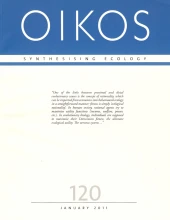Spent the morning in the symposium on the ecological consequences of intraspecific variation. An amazing lineup of speakers–the ones I saw (Dave Vasseur, Steve Ellner, Rick Lankau, Lauren Ancel Myers, Seb Schreiber, and Dan Bolnick) were all really excellent, full of penetrating insights. And the panel discussion afterwards was very good as well, even if it did throw a bit of cold water on my suggestion that it might be possible to write down a very general proof of the circumstances under which adaptive evolution promotes ecological coexistence. Intraspecific variation in ecology is clearly going to be a “hot” area in years to come, and for good reason. I especially liked the focus on the interesting dynamical consequences of intraspecific variation.
As an aside (which I can’t resist mentioning only because it concerns a topic on which I work), Rick Lankau made an unintentional mistake at the end of his talk when he implied that scramble competition does not allow scope for evolution to promote competitive coexistence. That’s wrong, as Rick himself admitted when I chatted with him afterwards (Rick didn’t mean to imply this, but the cartoon on his slide was misleading). The key point is that there has to be scope for trade-offs in order to get the sorts of evolution-based coexistence mechanisms which Rick talked about. A trade-off between, say, ability to take up N vs. P (i.e. a trade-off in the context of scramble competition) works just as well as any other trade-off. Indeed, Dave Vasseur and I proved precisely that back in 2008.
The afternoon saw yet another excellent student talk, this one a theoretical talk by Joe Simonis on how demographic stochasticity weakens the effects of dispersal on spatial synchrony of predator-prey cycles. I do still wonder if the really interesting behaviors of his model occur in ecologically-relevant regions of parameter space. After all, predator-prey cycles typically are spatially synchronized in nature, and the Moran effect is pretty bad at synchronizing nonlinear cyclic dynamics, leaving dispersal as the only plausible synchronizing mechanism for many predator-prey cycles. So if your model says that dispersal doesn’t actually work, that makes me wonder how often your model actually applies in nature. But bottom line, he did a very nice job.
Spencer Hall was energetic as always, indeed perhaps too energetic–at one point he wandered out past the projector down the central aisle of the room! He was like the lead singer in a band going up to the edge of the stage to high-five the audience; I was afraid he was going to try to crowd-surf. 😉 Spencer showed that the famous “healthy herd” hypothesis (predators keep their prey healthy by culling sick individuals) doesn’t work in Daphnia–indeed, heavily-predated Daphnia populations are heavily-diseased, unhealthy herds–and lined up a couple of alternative hypotheses to explain this. He went a bit slowly for my taste, but that might just be me, it was still quite the performance.
Other highlights:
Great moments in flattery: Steve Ellner showed a method for partitioning out the effects of evolution on ecological dynamics, which he credited me for prompting him to develop, saying that I had reminded ecologists about the Price equation, on which Steve’s approach is based. I thanked Steve afterwards for his very kind remark.
Great moments in flattery #2: Sarcozona interviewed me for her fine blog. She actually paid her way to the meeting by soliciting donations from her readers, promising to interview one ecologist for every $100 raised. I never would’ve thought of that, and certainly wouldn’t have thought it would work, but it actually worked so well that she not only had all her travel paid for, she was struggling to find the time to interview enough people to keep up her end of the bargain. She asked me questions posed by her readers, some aimed at me specifically and some which she asked of all her interviewees. She should be posting the interviews in the next couple of weeks, and I’ll link to them when she does. I’m flattered to have been asked to do this, and I’m really looking forward to reading all the interviews.
An idea for a new kind of oral session: I was lucky to be invited to tag along to lunch with the intraspecific variation symposium speakers. It was a great conversation, so great I wished others would’ve been able to listen in. Indeed, I jokingly suggested that the ESA meeting should offer a new kind of oral session, which would consist of Dan Bolnick sitting in the front of the room talking about whatever came into his head. It could be called “An Afternoon with Dan Bolnick” or “Stuff Dan Bolnick Knows” or maybe “Dan’s Brain Dump”. And it would be awesome. 😉
Just for fun, in the comments you can suggest ecologists or evolutionary biologists who you’d want to just sit and listen to for an extended period of time (say, a couple of hours or more).


[…] sole-authored papers). And I’m proud that that way of doing things occasionally draws very flattering comments from colleagues who I really admire. And while my peak may never be that high, I like to think that […]
By: “I want to be the [famous non-scientist] of science” « Oikos Blog on May 10, 2012
at 3:25 pm